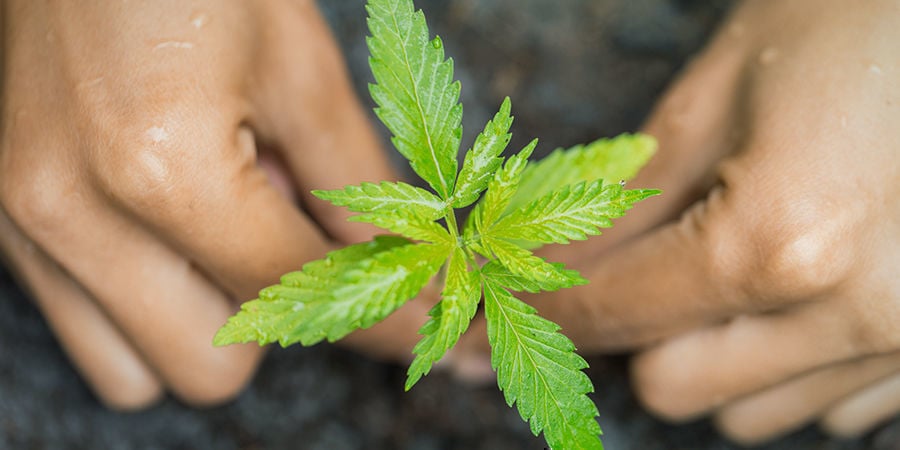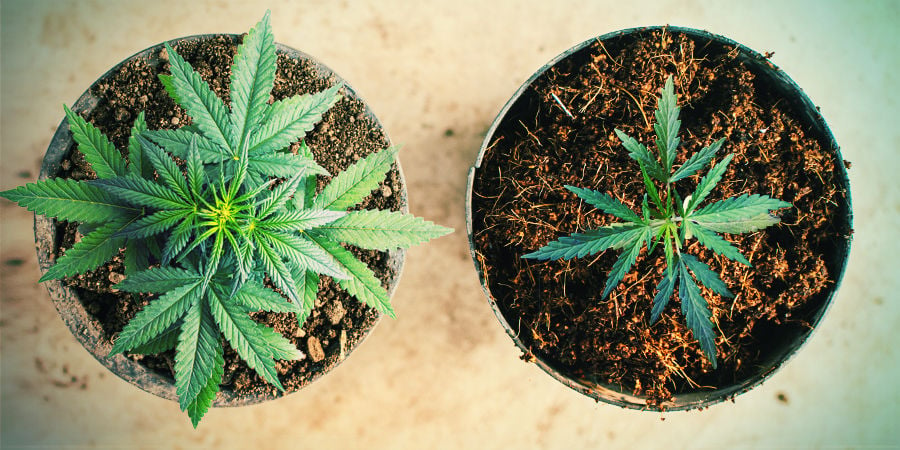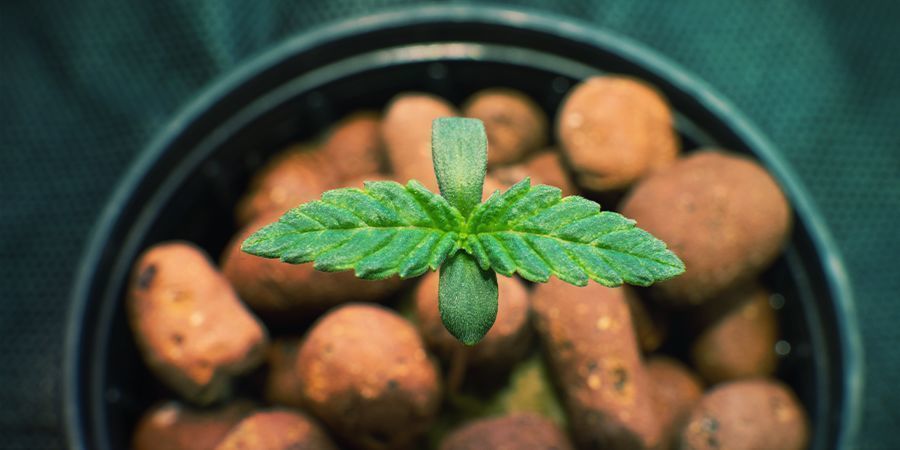
Should You Grow Cannabis Using Soil, Coco Or Hydroponics?
Should you grow your weed in soil, coco coir or hydroponics? Below, we take a look at the different growing media you can use to cultivate cannabis, along with their pros and cons.
Although fairly easy to learn, growing cannabis is an art that takes time to master. One foundational aspect of any grow is the growing medium used. There are quite a few out there, from soil and coco to water-based nutrient solutions (hydroponics), with each having its own pros and cons.
WHAT IS A CANNABIS GROWING MEDIUM AND WHY DOES IT MATTER?
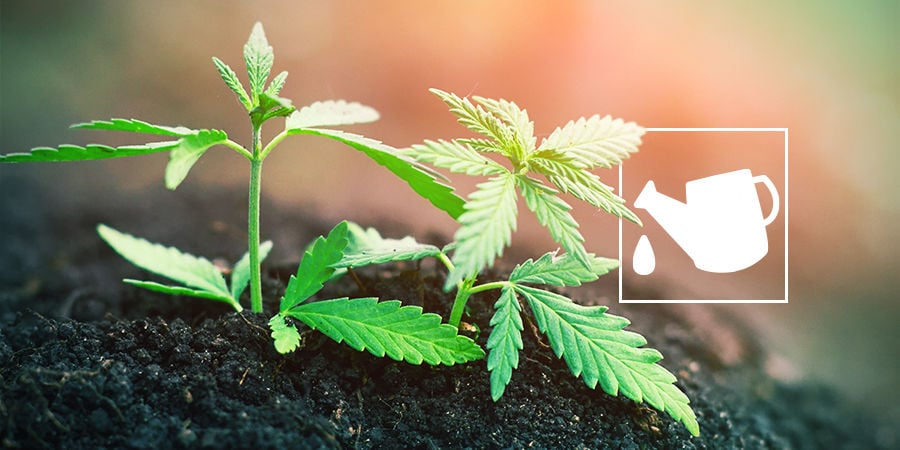
The growing medium, or substrate, is where your cannabis plants develop their roots. The most common medium is soil, but you can also grow in other media such as coco coir, rockwool, clay pebbles, or perlite, just to name a few.
With some growing methods, like hydroponic setups, the roots of your plants do not require a traditional substrate at all, but are instead suspended directly in a nutrient solution.
The thing is, cannabis can grow well as long as the roots have access to water, oxygen, and the proper nutrients. There is no one-size-fits-all growing medium or cultivation method, as each has its advantages and drawbacks. Which one you choose will depend on various factors. To help you decide, let’s look at the differences between growing in soil, coco, and hydroponics.
GROWING CANNABIS IN SOIL
Growing in soil is the most forgiving method, and it’s also the most natural—just like Mother Nature intended. The roots of your plants draw in the nutrients they need from the soil, which is supplemented by the gardener with water and, depending on soil quality, extra nutrients.
What speaks for growing in soil is that it is easy and straightforward. Good soil is widely available, and all you need is a pot and some high quality cannabis seeds and you’re good to go. Some cultivators will say that growing in soil—especially when done organically—produces the best-tasting weed. Then again, your yield may not turn out as big as with hydroponics or coco.
PROS AND CONS OF USING SOIL
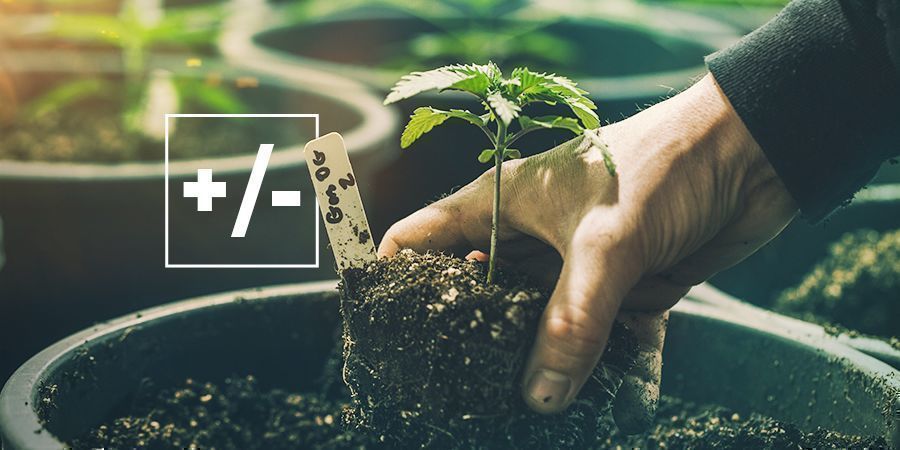
Growing cannabis in soil is popular for a reason. Not only is it the most tried and tested method, but the easiest and most accessible as well. This is the substrate of choice among beginners, most organic growers, and guerrilla growers. Good-quality soil normally contains enough nutrients to sustain most or all of your plant’s vegetative stage, allowing you to save on nutrients and cut back on fertilisers. Moreover, soil is more forgiving when it comes to pH, self-correcting as best as possible. Growers also tend to enjoy the flavour of soil-grown cannabis over any other.
On the other hand, soil-grown plants tend to move through the veg phase slower and deliver smaller yields by comparison. This also means plants will be slower to show signs of disease or deficiency, which you will need to look out for. Soil can easily accumulate mineral salts, requiring you to flush the substrate to prevent nutrient lockout and other issues. Although finding the correct soil for cannabis is not impossible, if you choose a soil that isn’t well-draining, your grow will be practically over before it has a chance to start.
| Advantages | Disadvantages |
| ✅ Growing in soil is easy and beginner-friendly | ❌ Soil tends to be the slowest method, with lower yields |
| ✅ Good soil contains enough nutrients for vegetation | ❌ Higher chance of pest infestations, mould, and disease |
| ✅ Soil is more forgiving when it comes to pH | ❌ Nutrient salts build up, requiring you to “flush” the soil |
| ✅ Growing organically in soil is the authentic way | ❌ Not all soils are optimal for cannabis |
| ✅ Cannabis grown in soil may have a better taste | ❌ It takes longer for plants to show signs of an issue |
GROWING CANNABIS USING COCO COIR
Growing cannabis in coco coir is sort of in-between growing in soil and growing hydroponically. It offers advantages of both, yet it doesn’t require an elaborate setup (pumps, tank, etc.) like hydroponics does.
Like perlite, clay pebbles, or vermiculite, coco coir is what’s called an inert growing medium. This means it doesn’t contain nutrients on its own, but is instead used for structural support. When growing in coco coir, you have to give nutrients to your plants from the start.
Oftentimes, growers don’t just use plain coco coir when growing weed, but add a bit of perlite as well. Adding perlite makes the substrate airier and improves drainage. This benefits root development, and thus encourages the healthy growth of your cannabis.
PROS AND CONS OF USING COCO COIR
.jpg)
Coco offers the best of both worlds as a substrate. Plants will grow almost as fast as with hydroponics, with equally top-notch yields, yet with the ease of growing in soil. You have full control over nutrients and pH, and the fibrous husk material gives roots support. Coco is a renewable resource that is more eco-friendly than soil, and is often amended with perlite or even soil to create an ideal mix for cannabis.
In terms of downsides, coco is much more susceptible to pH and nutrient issues due to over/underfeeding. It naturally has the tendency to leach magnesium and calcium, meaning you’ll have to amend your substrate with these nutrients to provide adequate amounts. In general, coco requires nutrient supplementation from the start, putting the onus on you to administer feed at the correct times, in the correct amounts. Coconut husks are often soaked in salt water or treated with chemicals before sale, requiring you to rinse the substrate before use. Finally, sourcing coco is easy online, but it can be difficult to find in some local stores.
| Advantages | Disadvantages |
| ✅ Plants grow (almost) as fast as with hydroponics | ❌ pH and nutrient problems can occur |
| ✅ Yields are excellent | ❌ Coco has a tendency to leach Mg and Ca |
| ✅ You have full control over nutrients and pH | ❌ You may need to rinse the substrate before use |
| ✅ As easy as soil, as productive as hydro | ❌ Requires supplementary nutrients from the start |
| ✅ Coco coir is a renewable resource | ❌ Finding coco locally can be an issue |
GROWING CANNABIS USING HYDROPONICS
Growing cannabis in a hydroponic system involves using water as the main growing medium. The roots of your plant are suspended in a dark box or sit in an inert growing medium suitable for hydroponics. A water-based nutrient solution is then drip-fed to the roots, keeping the plant sustained. This can offer a lot of advantages—especially where control is concerned—but it also comes with its own set of drawbacks.
There are various hydroponic methods that differ according to the inert growing media used and the way nutrients are administered. In addition to systems where the roots are suspended directly in water, there are also setups where the plants sit in rockwool, clay pebbles, or perlite as water and nutrients are fed to them.
Hydroponic setups can range from rather simple to elaborate. Often, they feature a tank for water and nutrients, pumps, drippers, and special hydroponic planting pots.
PROS AND CONS OF USING HYDROPONICS
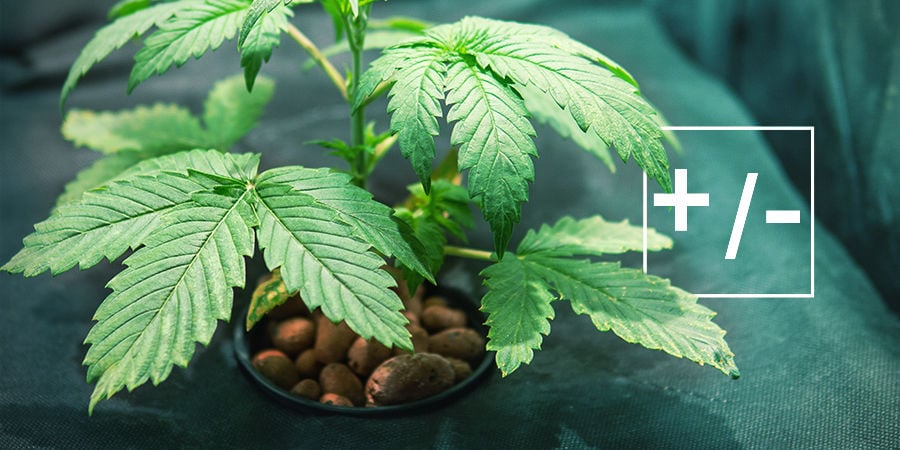
Hydroponics is something we tend to associate with expert growers. These systems allow growers almost complete control over pH and nutrient levels. If set up successfully, a hydroponic grow can result in accelerated growth and big yields as there is no soil buffer to keep nutrients from reaching the roots. You also don’t need to worry about soil-based diseases or pests. Any potential issues can be observed and mitigated quickly, and plants can recover faster.
At the same time, if not dealt with quickly, pH and nutrition issues can really set your grow back. Also, water-based diseases are still a threat to your crop. Furthermore, it’s harder to grow organically since you are responsible for administering all the supplemental nutrients yourself, which may adversely affect the taste as well. Finally, these systems are somewhat expensive and complex to run, making them unsuitable for first-timers.
| Advantages | Disadvantages |
| ✅ Hydroponic systems offer full control | ❌ More complicated (and expensive) than soil |
| ✅ Plants grow fast and produce big yields | ❌ Leaves little room for error |
| ✅ You don’t need to feed as much | ❌ Harder to grow organically |
| ✅ No soil-based diseases or pests | ❌ Water-based diseases are still a threat |
| ✅ Plants can recover faster | ❌ Your cannabis may not taste as good |
OVERVIEW AND COMPARISON OF CANNABIS GROWING MEDIA
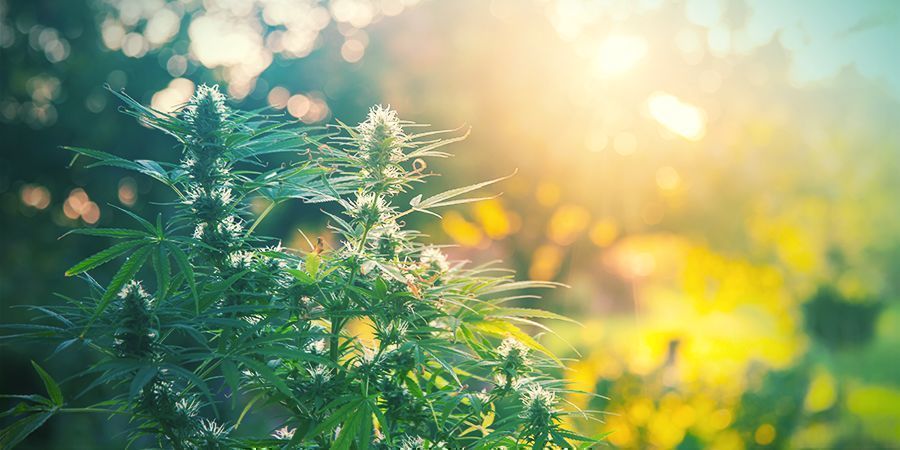
We hope the above guide has helped you better understand the differences between each growing medium, and why you might select one over the other. Just remember, no growing medium is “best”—it really comes down to personal preference, resources, and your goals as a grower.
Consider a soil grow if:
- you are not yet confident in your skills
- you want to keep things organic
- you want the flexibility of being less attentive to your plants
- you feel that soil-grown weed tastes better
Consider the hybrid option of coco coir if:
- you want the best of both worlds
- you want full control over nutrients and the structural support offered by coco
- you want to get your feet wet with hydro, but don’t want to risk it all
Consider a hydroponic system if:
- you want absolute control
- you are happy to dedicate the time and effort required
- you are confident in your skills
- you want larger, faster yields
Happy growing!
-
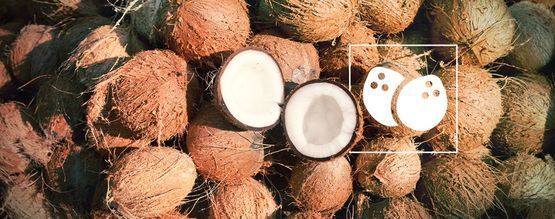 6 min
12 May 2025
Everything you need to know about growing cannabis in coco...
Perfect for everything from mixing with soil to using in a hydroponic setup, coco coir can be a fantastic substrate for cultivating cannabis plants. Read all about how to do it below.
6 min
12 May 2025
Everything you need to know about growing cannabis in coco...
Perfect for everything from mixing with soil to using in a hydroponic setup, coco coir can be a fantastic substrate for cultivating cannabis plants. Read all about how to do it below.
-
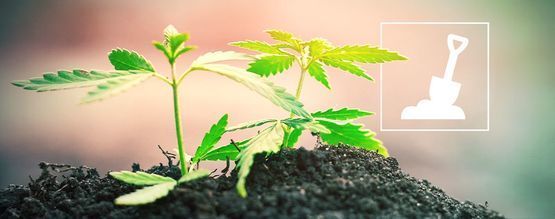 5 min
30 June 2022
Everything You Need To Know About Growing Cannabis In Soil
While it may initially seem tricky, we assure you, finding the right soil for growing cannabis needn’t be stressful. We delve into everything you need to know about the ideal soil for weed, other...
5 min
30 June 2022
Everything You Need To Know About Growing Cannabis In Soil
While it may initially seem tricky, we assure you, finding the right soil for growing cannabis needn’t be stressful. We delve into everything you need to know about the ideal soil for weed, other...
-
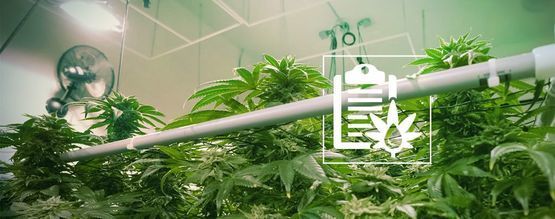 3 min
31 July 2020
The Different Types Of Hydroponic Systems For Growing Cannabis
Hydroponics offers growers big yields and fast results. Some methods are simple and cheap, whereas others are much more intricate and advanced. Check out the six most popular hydro methods below.
3 min
31 July 2020
The Different Types Of Hydroponic Systems For Growing Cannabis
Hydroponics offers growers big yields and fast results. Some methods are simple and cheap, whereas others are much more intricate and advanced. Check out the six most popular hydro methods below.
-
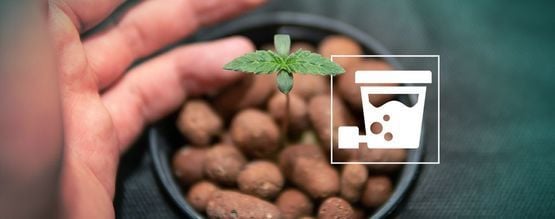 6 min
5 February 2020
How To Grow Huge Yields Of Cannabis Using DWC Hydroponics
Abundant yields in less time with fewer resources? This is the promise of growing cannabis in a hydroponic system. When it comes to deep water culture (DWC), what are the benefits and drawbacks?...
6 min
5 February 2020
How To Grow Huge Yields Of Cannabis Using DWC Hydroponics
Abundant yields in less time with fewer resources? This is the promise of growing cannabis in a hydroponic system. When it comes to deep water culture (DWC), what are the benefits and drawbacks?...
-
 11 min
13 June 2019
Growing Cannabis With Hydro
Growing cannabis with hydroponics can really push a crop far past the natural potential. It offers many advantages to the grower willing to take on more of a challenge, and rewards hard effort and...
11 min
13 June 2019
Growing Cannabis With Hydro
Growing cannabis with hydroponics can really push a crop far past the natural potential. It offers many advantages to the grower willing to take on more of a challenge, and rewards hard effort and...





 United States
United States

